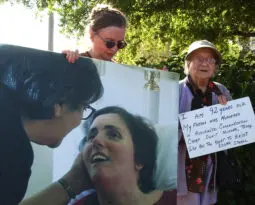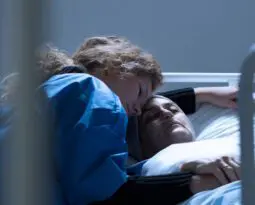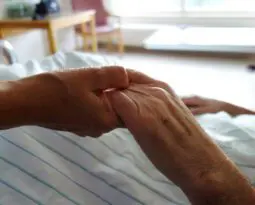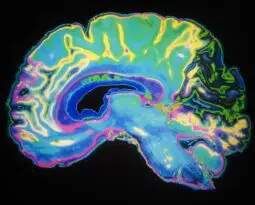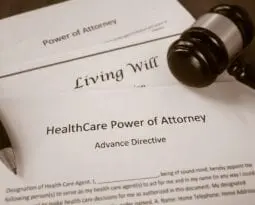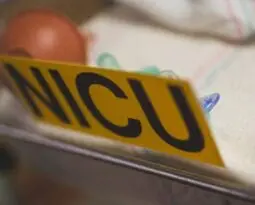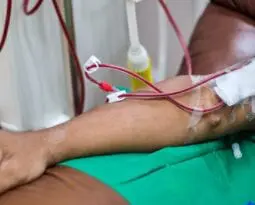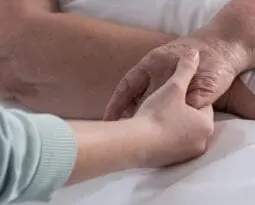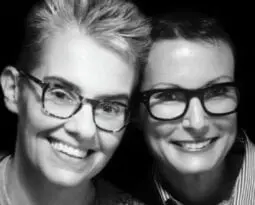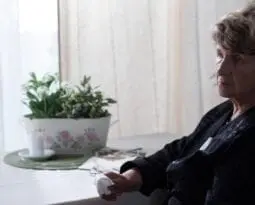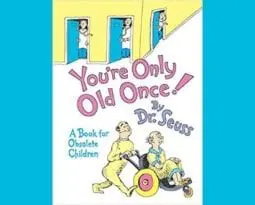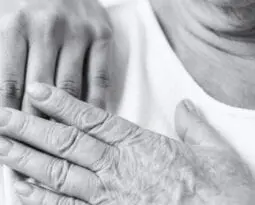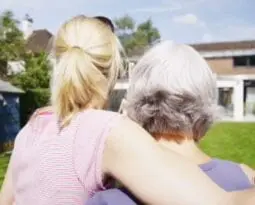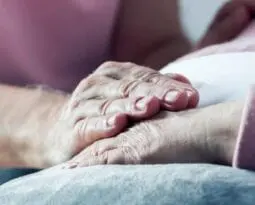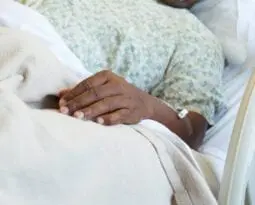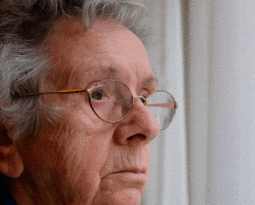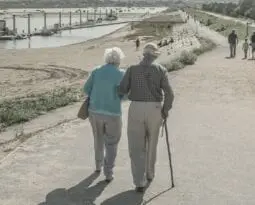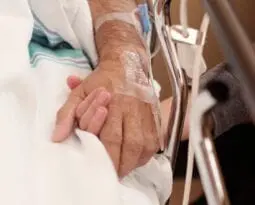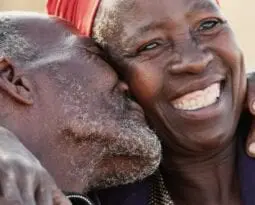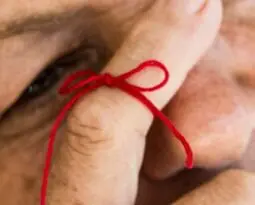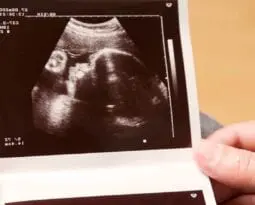Ethics and the End of Life
Selected resources from The Hastings Center.
Bioethics Briefings:
End of Life Care
The central philosophical question in end-of-life care is how to make decisions surrounding the numerous choices about what treatments to administer, taper off, cease, or withhold at the end of life. Traditionally, ethicists have considered patients’ wishes to be paramount; however, some believe that other interests should be considered, such as the wishes of family members. Read our briefing to consider: how should different interests be prioritized in end-of-life decision-making?
From Hastings Bioethics Forum:
- A Clinical Ethicist Reflects on the Life and Death of a Beloved PetIn my role as a clinical ethicist, I regularly explore the risks and benefits of proposed treatments, especially for terminal diseases. But for Sheba this moral question felt unique.
- Pregnancy, Brain Death, and the Right to Choose: Lessons from the Adriana Smith CaseBrain death during pregnancy presents complex ethical and legal questions regarding whether––and under what circumstances–any fetal interests or rights take precedence over those of a pregnant person….
- Terri Schiavo’s LegacyMany think that the decision 20 years ago to permit Terri Schiavo to die was a victory for medical choice. On the contrary, her death triggered a series of events that have corroded individual control over medical care in the United States.
- It’s Time to Change the Conversation About MAiDIn a recent commentary, physician Alan Astrow expressed skepticism about the legalization of medical aid in dying. He cited the subjectivity of determining whose suffering qualifies for…
- Does Calling Severe Anorexia a Terminal Condition Matter?What is at stake in calling extreme, end-stage anorexia nervosa a terminal condition? It may be thought to have implications for end-of-life decisions. I will argue that this is a mistake, although one that needs explanation.
- Hospice and Medical Aid-in-Dying: Addressing an Unethical DisconnectMost patients who die with medical aid in states where the practice is legal are enrolled in hospice, but coordination between those providing hospice care and those providing medical aid-in-dying (MAiD) is woefully inadequate. Many hospice facilities have policies against supporting patients who request MAiD and do not disclose these policies to prospective patients, even in states where disclosure is required.
- After Roe, What’s Next for End-of-Life Care?The reversal of Roe may be the beginning of an onslaught on our freedoms. I want to add one more worry to the list and point to self-determination at life’s end. Here we have Justice Neil Gorsuch to worry about.
- MAID Without Borders? Oregon Drops the Residency RequirementOregon, which legalized medical aid in dying (MAID) in 1997, has dropped the requirement that had limited MAID access to residents of the state. What are the ethical and social implications of this policy change?
- The Death of Advance Care Planning is Greatly ExaggeratedAdvance care planning has recently come under fire from physicians who say that it does not work and that there is too little evidence in favor of it. Giving up on advance care planning is not called for by the evidence and doing so would mean giving up significant benefits.
- Individuals Declared Brain-Dead Remain Biologically AliveA remarkable experiment raises anew questions about whether brain-death is really death.
- Quality of Life? Suffering? Covid-19 Intensifies Challenges in Discussing Life-Sustaining TreatmentThe pandemic magnified the inherent difficulty and stress of conversations involving life-sustaining treatment by forcing clinicians and patients to engage in life-altering discussions via telephone and video conference, restricting nonverbal communication and eye contact, and eliminating the benefit of simply having another person nearby in time of crisis.
- “You Can See Your Loved One Now.” Can Visitor Restrictions During Covid Unduly Influence End-of-Life Decisions?One of the factors considered most important by dying patients and their families is the opportunity to be together. For many of our hospitalized patients in palliative care, the presence of loved ones at the bedside is such a given that we don’t even address it explicitly in advance care planning discussions. So, it comes as no surprise that Covid- 19-related visitor restrictions affecting hospitalized patients might impact end-of-life decision-making, potentially in ways that are ethically problematic.
- Covid-19 Underscores Racial Disparity in Advance DirectivesOlder black Americans are half as likely as older whites to have advanced directives. My patient, a black man in his 70s,, first made his wishes known when he was in the hospital with Covid-19.
- Please Don’t (Need to) Use My WorkI helped develop guidelines for the ethical allocation of scarce resources during a public health emergency, such as a pandemic..I hope my contributions have an impact. I especially hope to see my work used since it emphasizes the perspectives of minority and underserved communities, who tend to have less voice in health policy. But now I find myself dreading the use of my work.
- Do New York State’s Ventilator Allocation Guidelines Place Chronic Ventilator Users at Risk? Clarification NeededThere is a lack of clarity about the New York State Task Force guidelines on ventilator allocation. I believe disability rights concerns regarding the recommendations on chronic ventilator users are well-founded. This lack of clarity may cost lives.
- Confronting Disability Discrimination During the PandemicAs hospitals and public health authorities devise triage protocols to allocate scarce critical-care resources during the Covid-19 pandemic, people with disabilities are expressing alarm that these protocols devalue them and exacerbate long-entrenched ableism in health care. Lawsuits alleging disability discrimination in have been filed in Washington and Alabama. The U.S. Office for Civil Rights is investigating disability discrimination complaints in triage protocols. The challenge is to develop protocols that will minimize discrimination in the health care system.
- Deciding When Enough is Enough in Providing Life-Sustaining Treatment for a ChildTinslee Lewis, a critically ill 1-year-old girl born with a rare heart defect and severe lung disease, has spent her entire life in the intensive care unit at Cook Children’s Hospital in Texas and undergone multiple surgeries in attempts to save her life. Tinslee’s care team has determined that she has no chance for any meaningful survival and that ongoing intensive care is harmful and causing her undue suffering. They recommend withdrawal of life-sustaining treatment, against the parent’s wishes. Tinslee’s fate is being debated in court.
- Revising the Uniform Determination of Death Act: Response to Miller and Nair-CollinsTo address recent lawsuits that question whether the persistent of hormonal functions is consistent with death by neurologic criteria (such as the case of Jahi McMath), we proposed specific mention in a UDDA that loss of hormonal functions is not required for declaration of death by neurologic criteria.
- A Responsible DeathAs debates continue about the decisions people make about how to die, I wish to draw wider attention to the death of Paul Drier. There was little extraordinary about his death. He was a widower, had suffered from multiple health problems, and had been on kidney dialysis for 18 months. Considered to be too ill to qualify for a transplant, he decided to end dialysis. Two aspects of Mr. Drier’s death seem worth putting on record for bioethicists to remember.
- An Incoherent Proposal to Revise the Uniform Determination of Death Act
- Is Medical Aid in Dying a Human Right? Another ViewAn essay for Bioethics Forum earlier this month concludes that medical aid in dying is not a human right. But we should have a right to decide what suffering we are willing to endure and receive medical assistance necessary to avoid the suffering we want to avoid.
- Physician-Assisted Death and Journalism EthicsA New York Times special report on euthanasia of a Paralympics champion in Belgium was ethically problematic for several reasons.
- Is Medical Aid in Dying a Human Right?The Kings County Medical Society in New York recently hosted a brunch with New York State legislators. One of the guests was Richard Gottfried, chair of the New York State Assembly Health Committee, who is cosponsoring A2694, a bill legalizing medical aid in dying (MAID). As a medical oncologist with 30 years’ experience treating seriously ill patients, I have concerns about it, and I expressed them to Gottfried.
- Live-Tweeting About Dying: Last Lessons from Kathy BrandtKathy Brandt, a leader in the hospice and palliative care movement in the United States, died on August 4. She was 53 and had been diagnosed with a rare, highly aggressive form of ovarian cancer in January. Brandt and her wife regularly posted on social media about their family’s end-of-life experiences.
- Religion, Suffering, and the Physician’s RoleShould religion play a role in a doctor’s care of seriously ill patients? The author, a hematologist/oncologist who teaches Jewish medical ethics, writes: “A physician’s outlook may be shaped by religious standards without having to impose it on the patient.”
- Should Feeling Tired of Life Be Grounds for Euthanasia?Should an elderly person in decent health but “tired of life” be able to die with a physician’s assistance? The Netherlands is grappling with this question.
- What Dr. Seuss Saw at the Golden Years Clinic“Improving patient experience” has become the mantra of many health care facilities in a highly competitive and regulated environment. But just what is it about the patient…
- Old JewsOld Jews are why I am who I am. Not only the old Jews you’d expect–my grandparents and great-grandparents, who came here because, as I learned for…
- Ethical Perspectives on Advance Directives for DementiaFour articles in the Hastings Center Report make an array of claims about whether advance directives should or should not be used to instruct caregivers to withhold…
- Avoiding Dementia, Causing Moral DistressIn “Avoiding Deep Dementia,” an essay in the current issue of the Hastings Center Report, legal scholar Norman Cantor explains why he has an advance directive that…
- Jahi McMath, Race, and BioethicsTwice upon a time, there was a girl who died. The death certificate that New Jersey issued to 17-year-old Jahi McMath on June 22 was the second…
- Envisioning Civic Palliative CareDying cannot be understood properly, or responded to well, without recourse to the connections between the dying experience and the larger social structures that make up a…
- A Single-Payer Bubble?In an earlier piece, “Trumping Drug Costs,” I looked at out-of-pocket costs as the pivotal issue with drugs. They can be a particularly heavy burden on the…
- Love and Boundaries in MedicineIt’s a little-known and rarely discussed fact of medical practice that doctors value the ability to love our patients. If the thought of doctors loving patients makes…
- Hawaii’s New End-of-Life Law: Do the Additional Safeguards Withstand Scrutiny?Last month, Hawaii became the seventh state, with the District of Columbia, to legalize physician-assisted suicide. Similar to some of the other state laws, Hawaii’s Our Care,…
- Palliative Care vs. Cancer ResearchThe death of former first lady Barbara Bush at age 92 was noteworthy in many ways. She was by all accounts smart, sharp and funny, and a…
- Evaluating Recommendations to Increase Organ DonationWhile the U.S. system of organ donation and transplantation is in a state of growth for the fifth year in a row, the call for new strategies…
- “No one was listening to us.” Lessons from the Jahi McMath Case“It was like he thought we were dirt.” This is how Jahi McMath’s grandmother, Sandra, describes having been treated by one of the doctors at the Oakland’s…
- Does the Future Belong to Assisted Death?I have been opposed to physician-assisted death for well over 30 years. I need to go back to my early days with this issue to lay out…
- Vive la Bioéthique? France’s Bioethics InitiativeLittle noticed in the United States but a big deal in France, President Emmanuel Macron announced in January that he is creating a bioethics commission to review…
- Should We Get Ready for Prime Time?For the first few years after my husband Howard died, I talked to him often. These were not ghostly, paranormal encounters; I was just thinking out loud…
- Has Physician-Assisted Death Become the “Good Death?”“Death with dignity” for the past 40 years has meant, for many people, avoiding unwanted medical technology and dying in a hospital. A “natural” death at home…
- Who “Persists” in Opposing DNR Orders? Demographics MatterReading “After DNR: Surrogates who persist in requesting cardiopulmonary resuscitation” in the Hastings Center Report, I was reminded of Senate Majority Leader Mitch McConnell’s chastisement of Senator…
- Neil Gorsuch, Aid in Dying, and Roe v. WadeGiven the chance, would Supreme Court nominee Neil Gorsuch vote to overturn Roe v Wade? Challenge state “death with dignity” laws?
- Is Death in Trouble?Death is beginning to show its age, though I hesitate to even mention that possibility. With an obviously big ego and its intimidating black cloak and scythe,…
- The Lady Writer and the Valkyrie: Magda Szabo’s Novel The DoorAn old woman desperately needs medical attention. Yet she fiercely refuses every offer of help from friends, neighbors, and the local doctor. No one will get past…
- Sweet Grapes at the End of LifeMs. Rita, whom I met as a volunteer at a local nursing home, was the most ardent lover of grapes I have ever known. She was confined…
- On Living to 100 or MoreSometime around my mid-50’s I began to ask myself a question: how long should I want to live? My father had died at 64, my mother at…
- Assisted-Dying Provisions: California Legislature Says Yes, the U.K. Says NoA new chapter in efforts to secure legal provisions for physician-assisted dying began last week when the California State Legislature voted to approve the End of Life Option Act….
- The Medical Humanity of Oliver Sacks: In His Own WordsWe science-medicine-poetry junkies, along with a sizeable portion of the world’s population, are mourning the death of Oliver Sacks, the neurologist and author who died last Sunday from metastasized…
- Beyond the “Silver Tsunami”: Toward an Ethic for Aging SocietiesI spent last week in Singapore, where an excellent breakfast of noodles and teah o ais limau (Malaysian-style iced tea with lemon) costs about $2 and is served at…
- Why New Zealand Should Permit Aid in DyingHaving read with interest Josephine Johnston’s essay on the aid-in-dying case before a court in New Zealand, I’d like to elaborate on some salient points. I have been…
- Sex, Consent, and DementiaA 78-year‐old Iowa man, Henry Rayhons, has been charged with third‐degree felony sexual abuse for having sex with his wife, who had severe Alzheimer’s, in her nursing home…
- Dying: Closing the Gap between What We Know and What We DoTime is running out on fixing the way we die. As readers of this blog know, the courts first declared a right to refuse unwanted life-sustaining treatment…
- Controlling the End Game of DementiaIn her New York Times article of January 20, “Complexities of Choosing an End Game for Dementia”, Paula Span reviewed the use of advance directives to withhold food and water…
- How Brittany Maynard Changed the Conversation about Aid in DyingBrittany Maynard, the courageous 29-year-old woman with terminal brain cancer, ended her life a month ago today. She and her husband had moved to Oregon so that Maynard…
- More French ParadoxesDeath is hard to deal with anywhere, but France has some contradictory ways of providing end-of-life care, as two recent articles discuss. On the lighter side, Agence…
- Alzheimer’s Disease, Biomarkers, and Suicide: Why We Need to Think About All Three TogetherRecently, I spoke with a seasoned health care reporter who was interested in Alzheimer’s and biomarkers because of his own family’s history of this disease. He started…
- A Blood Test to Predict Alzheimer’s Disease: What’s the Elephant in the Room?I recently gave a talk about Alzheimer’s disease and asked people to imagine two individuals, Manny and Sue. Manny died at 85; he was showing signs of…
- Bioethics and the Dogma of “Brain Death”Two cases involving “brain death” have received considerable public attention, including commentary by several well-known bioethicists. In commenting on these cases the bioethicists have stated, in no…
- An ICU Nurse Discusses Brain DeathBrain death is an immensely challenging concept to grasp, even for health care providers. The patients look like any other patient in the intensive care unit; they…
- U.K.’s Landmark Case on Withholding Treatment Affirms the Importance of Patients’ ValuesFamily Lose Right-to-Life Case at U.K.’s Highest Court.” “Judges ‘Right’ to Allow Man to Die.” “Widow Loses ‘Withdrawn Treatment’ Case.” These were the headlines on a recent…
- Getting from “is” to “ought” Near the End of LifeThere is a saying in ethics: you can’t get an “ought” from an “is.” Descriptions of the world as it is do not reveal truths about the…
- Is Five Hours Too Short to Say Goodbye? My Dad’s Rapid AutopsyMy sister called: “Get the orange card out of my wallet on the table. We need to call the study people.” In July, we got the news…
- What if the Patient is Your Mother?The problems with end-of-life care are clear enough. Patients and their families/significant others still have trouble talking with one another and their doctors about how they would…
- A Peaceful Death or a Risk to People with Disabilities?Armond and Dorothy Rudolph of New Mexico were evicted from their assisted living facility in January 2011, after administrators called the police and rescue workers and informed…
- Goldilocks and the Three Hospice PatientsGoldilocks, all grown up and working as a Medicare hospice auditor, checks the records of three patients. She frowns at Mr. Brown Bear’s record. He was referred…
- Euthanasia in Belgium: The Untold StoryBelgian twins, Eddie and Marc Verbessem, were euthanized by lethal injection at Brussels University Hospital in Jette in December. The Verbessem brothers, deaf since birth, were cobblers by trade…
- The Death of a Pet: A Glimpse into the Human FutureFor some years I have been writing about end-of-life care and, of late, focusing on the high costs of that care. I recently had a painful but…
- The Trial of “Death by Medicine”: An Interview with Lisa KriegerOn February 5, Lisa Krieger, a science and medicine writer for the Mercury News in San Jose, Ca, published a remarkably moving and insightful article about the protracted dying of her…
From Hastings Center Report:
Cruzan after Dobbs: What Remains of the Constitutional Right to Refuse Treatment?
First published: 24 April 2023
Abstract
In 2022, the U.S. Supreme Court removed constitutional protection from the individual’s right to end a pregnancy. In Dobbs v. Jackson Women’s Health Organization, the Court invalidated previous rulings protecting that right as part of the individual liberty and privacy interests embedded in the U.S. Constitution. Now, many observers are speculating about the fate of other rights founded on those interests. The Dobbs ruling conflicts with the Court’s 1990 Cruzan decision restricting the government’s power to interfere with personal medical choices. The language and reasoning in Dobbs and Cruzan offer guidance on how the Court might address future cases involving the right to refuse life-sustaining treatment. The decisions also point to policy strategies for preserving that right.
Raising the Dead? Limits of CPR and Harms of Defensive Practices
First published: 20 December 2022
Abstract
We describe the case of an eighty-four-year-old man with disseminated lung cancer who had been receiving palliative care in the hospital and was found by nursing staff unresponsive, with clinically obvious signs of death, including rigor mortis. Because there was no documentation to the contrary, the nurses commenced cardiopulmonary resuscitation and called a code blue, resulting in resuscitative efforts that continued for around twenty minutes. In discussion with the hospital ethicist, senior nurses justified these actions, mainly citing disciplinary and medicolegal concerns. We argue that moral harms arise from CPR performed on a corpse and that legal concerns about failing to perform it are unfounded. We contend that such efforts are an unintended consequence of managerialist policies mandating do-not-resuscitate orders and advance care plans and of defensive practices that can value the interests of institutions and practitioners over those of patients. Health management teaching should include managerialism and its pitfalls, while clinician training should prioritize ethical reasoning and legal knowledge over defensive practice.
On the Authority of Advance Euthanasia Directives for People with Severe Dementia: Reflections on a Dutch Case
First published: 13 October 2022
Abstract
In 2016, a Dutch physician complied with the advance euthanasia directive of a patient with severe dementia. In the ensuing lawsuit, the physician was charged principally with termination of life on request, with euthanasia, that is, and alternatively with murder. A district court acquitted her of both charges, a decision later upheld by the Dutch Supreme Court.
Euthanasia is still a criminal offense in the Netherlands, but in 2002, a new euthanasia act came into effect allowing a physician to perform euthanasia if she has fulfilled six due-care criteria, the two most important of which are that she must be satisfied that the patient’s request is voluntary and well considered and that the patient’s suffering is unbearable, with no prospect of improvement. Neither of these two criteria is controversial; particular cases are controversial when it is disputed that these criteria were fulfilled. Other euthanasia cases, however, are controversial because they belong to a category that is contentious for independent reasons. One such disputed category is euthanasia performed on incompetent patients with an advance directive.
Since determining whether these criteria are fulfilled in a particular case depends on the particular circumstances, we describe this 2016 case in detail. We then focus on three general philosophical reasons for doubting the validity of advance euthanasia directives for incompetent patients: the someone else problem, the problem of response shift, and the problem of normative authority. These problems have been discussed before, but our primary aim is to show how they are connected. Taken together, we believe that our two lines of argument make a strong moral case for supporting the Dutch Supreme Court’s decision.
Advance Directives: The Principle of Determining Autonomy
First published: January 2022
Abstract
In medical ethics, there is a well-established debate about the authority of advance directives over people living with dementia, a dispute often cast as a clash between two principles: respecting autonomy and beneficence toward patients. In this article, I argue that there need be only one principle in substitute decision-making: determining authenticity. This principle favors a substituted judgment standard in all cases and instructs decision-makers to determine what the patient would authentically prefer to happen-based not merely on the patient’s decisions but also on their present settled dispositions. Adhering to this principle entails that, in a significant range of cases, an advance directive can (and indeed ought to) be overruled.
Ending One’s Life in Advance
First published: 24 May 2021
Abstract
If you developed Alzheimer disease, would you want to go all the way to the end of what might be a decade-long course? Some would; some wouldn’t. Options open to those who choose to die sooner are often inadequate. Do-not-resuscitate orders and advance directives depend on others’ cooperation. Preemptive suicide may mean giving up years of life one would count as good. Do-it-yourself methods can fail. What we now ask of family and clinicians caring for persons with dementia, and of patients given no better option than to go on with lives they may not want, is unacceptable. To explore how one might better control one’s own dying and avoid burdening others with overwhelming care and morally painful choices, we propose a thought experiment: an advance directive implant that would enable persons with early dementia, while competent, to arrange their own deaths without the subsequent intervention of anyone else.
When Following the Rules Feels Wrong
First published: 25 February 2021
Abstract
The Covid-19 pandemic has created a clinical environment in which health care practitioners are experiencing moral distress in numerous and novel ways. In this narrative reflection, a pediatric palliative care physician explores how his hospital’s strict visitation policy set the stage for moral distress when, in the early months of the pandemic, it prevented two parents from being together at the bedside of their dying child.
Walls
First published: 29 June 2020
Abstract
In a field that strives to care for patients and families together, what can palliative care clinicians do when patients’ families are physically absent? The Covid-19 pandemic has put both literal and figurative walls between health care professionals and families. How health care workers respond to these disconnections might have a lasting impact on patients, on families, and on our practice. Recently, I saw this in the case of a patient our palliative care team was consulted to see. Mr. B was minimally responsive and dying from multisystem organ failure of unclear etiology. As in other cases during this pandemic, our team became a facilitator of interaction between the patient and the physically absent family, seeing an intimacy we normally would not, in this case, by being present while our intern held the phone to Mr. B’s ear for an end-of-life call from his wife, son, and daughter. Such moments force us clinicians to be even more present for our families and patients, and they allow us to bear witness to the strength and sadness and love that we might otherwise miss.
Dying during Covid-19
First published: 29 June 2020
Abstract
I had been on the phone with Madeleine’s mother for fifteen minutes, and she had sobbed throughout. She pleaded with me, “You won’t even let our family visit her together. If you really want to help my daughter, you will let us stay with her.” Madeleine, who was twenty-four years old, was dying of end-stage acute myeloid leukemia and was intubated in one of our intensive care units. Her intensivist had requested a clinical ethics consultation for potentially inappropriate medical treatment—in my world of clinical ethics consultation, routine stuff. Except that, in March 2020, nothing was routine anymore. The Covid-19 pandemic calls for creative thinking about ad hoc and post hoc bereavement efforts, and it may result in efforts to revise existing accounts of what constitutes a good death in order to accommodate patients’ and families’ experiences at the end of life during a pandemic.
Learning from Covid
First published: 29 June 2020
Abstract
Mrs. Clark’s case was an ordinary consult in an extraordinary time. She was refusing dialysis, but the psychiatric unit had concluded that she lacked capacity for such decision-making. The only difference between Mrs. Clark’s current hospitalization and the last two was that it was April 2020 and a virus called Covid-19 had overtaken our hospital. As the chief of Montefiore Medical Center’s bioethics service, when I received a consult before the virus, I always saw the patient. Whether the patient had been in a vegetative state for a day or for years, it didn’t matter. I would lay my hand on a leg or an arm and observe. But Covid-19 enforced physical boundaries between my team and our patients; I would not be able to meet Mrs. Clark. Our hospital responded to the attack on human connection by getting creative. We asked ourselves, which tools are still available to us? Answering this involved, in part, finding new ways for our team of clinical ethicists to support the clinicians caring for Mrs. Clark.
Black Lives in a Pandemic: Implications of Systemic Injustice for End-of-Life Care
First published: 29 June 2020
Abstract
In recent months, Covid-19 has devastated African American communities across the nation, and a Minneapolis police officer murdered George Floyd. The agents of death may be novel, but the phenomena of long-standing epidemics of premature black death and of police violence are not. This essay argues that racial health and health care disparities, rooted as they are in systemic injustice, ought to carry far more weight in clinical ethics than they generally do. In particular, this essay examines palliative and end-of-life care for African Americans, highlighting the ways in which American medicine, like American society, has breached trust. In the experience of many African American patients struggling against terminal illness, health care providers have denied them a say in their own medical decision-making. In the midst of the Covid-19 pandemic, African Americans have once again been denied a say with regard to the rationing of scarce medical resources such as ventilators, in that dominant and ostensibly race-neutral algorithms sacrifice black lives. Is there such thing as a “good” or “dignified” death when African Americans are dying not merely of Covid-19 but of structural racism?
Avoiding Ineffective End-of-Life Care: A Lesson from Triage?
First published: 29 June 2020
Ethicists and physicians all over the world have been working on triage protocols to plan for the possibility that the Covid-19 pandemic will result in shortages of intensive care unit beds, ventilators, blood products, or medications. In reflecting on those protocols, many health care workers have noticed that, outside the pandemic shortage situation, we routinely supply patients in the ICU with invasive and painful care that will not help the patients survive even their hospitalization. This is the kind of pointless care that even the most basic protocol would triage against. Perhaps this widespread reflection on triage standards will draw our attention to our ongoing custom of supplying burdensome and inefficacious care to those near the end of life—care that most health care providers would not want for themselves. This essay argues that reflecting on triage could help us improve end-of-life care.
Homeless, Ill, and Psychiatrically Complex: The Grueling Carousel of Cassandra Lee
First published: 20 August 2019
Abstract
Ask any clinical ethics consultant, and they can tell you about their transformative cases. Some stick with us because all roads led nowhere. Cassandra Lee had a history of pulling out lines and tubes and a distaste of warming blankets. Her admission marked her thirtieth over the past year. Many of the challenges facing the hospital caring for her were not unique: significant psychiatric issues, prolonged nonadherence to medical advice, and end-of-life decision-making combined to create an ethically dense and vexing situation. Ms. Lee, like so many patients, was suffering because of system failures.
When No One Notices: Disorders of Consciousness and the Chronic Vegetative State
First published: 20 August 2019
Abstract
On January 5, 2019, the Associated Press reported that a woman thought to have been in the vegetative state for over a decade gave birth at a Hacienda HealthCare facility. Until she delivered, the staff at the Phoenix center had not noticed that their patient was pregnant. The patient was also misdiagnosed.
Misdiagnosis of patients with disorders of consciousness in institutional settings is more the norm than the exception. Misdiagnosis is also connected to a broad and extremely significant change in the understanding of the vegetative state—a change that the field of bioethics has not yet fully taken into account. In September 2018, the American Academy of Neurology, the American College of Rehabilitation Medicine, and the National Institute on Disability, Independent Living, and Rehabilitation Research issued a comprehensive evidence-based review on disorders of consciousness and an associated practice guideline on the care of these patients. These landmark publications update the 1994 Multi-Society Task Force Report on the Vegetative State, which subcategorized the persistent vegetative state as either persistent (once the vegetative state lasted one month) or permanent (once the vegetative state lasted three months after anoxic injury or twelve months after traumatic injury). Noting that 20 percent of patients thought to be permanently unconscious might regain some level of consciousness, the new guideline has eliminated the permanent vegetative state as a diagnostic category, replacing it with the chronic vegetative state.
Dying with Dignity; Living with Laws (and Ethics)
First published: 03 July 2019
Abstract
An increasing number of jurisdictions allow individuals to obtain medication prescribed by their physicians for medical assistance in dying (MAID). But discussion of whether (and to what extent) individuals have the right to use the health care system to control the time and manner of their death is not limited to MAID. The right also exists in other contexts, such as directing the withdrawal of life-sustaining treatments. Palliative (or terminal) sedation involves medications to render a patient unconscious, coupled with either the withdrawal of artificial nutrition and hydration or their not being administered at all. In high-enough doses, these medications may further suppress already-weakened cardiopulmonary function even if there is no intent to hasten death. When teaching about these topics, I challenge students to consider whether there are meaningful differences between practices like euthanasia, MAID, aggressive use of morphine, terminal sedation, or the withdrawal of ventilator support. Whether their differences are morally, ethically, or legally meaningful can be difficult to tease out. After recently watching a loved one, whom I call “Stephan,” direct the time and manner of his death within hospice care in a state that does not allow MAID, I am less inclined than ever to believe that the differences are meaningful in a way the law should recognize.
Changing the Question
First published: 18 April 2019
Abstract
Jack, who is seventy-five years old, is in the hospital with a terminal condition that has undermined his cognitive faculties. He has left no advance directive and has never had a conversation in which he made his treatment wishes remotely clear. Yet now, a treatment decision must be made, and in modern American medicine, the treatment decision for Jack is supposed to be made by a surrogate decision-maker, who is supposed to use a decision-making standard known as “substituted judgment.” According to the substituted judgment standard, Jack’s surrogate decision-maker, his wife, is supposed to decide on his treatment by determining what Jack would do if he did have decisional capacity. That is, she is supposed to answer the question, what would the patient choose? I will argue that this is the wrong question to ask because when the question has a determinate answer, that answer is sometimes not sufficiently connected to the value that is supposed to make the question morally salient, and because sometimes, perhaps often, there is no determinate answer to the question of what the patient would choose. Jointly, these two problems suggest the need for a different question.
Requests for PAD and the Assessment of Capacity
First published: 21 February 2019
Abstract
I was asked to evaluate M by her medical oncologist, Dr. T. As a psychiatrist, I was to perform the duties of a mental health specialist in the care of this fifty-eight-year-old woman with metastatic breast cancer who had requested physician aid in dying. Dr. T had no specific concerns, but she was adhering to the letter of the law by referring the patient to me—a “mental health specialist”—because, according to the patient’s medical history, there was “evidence of a mental disorder.” That evidence was comprised of depression treated in the remote past.
Some years before California passed its End of Life Options Act in 2015, M had begun talking with Dr. T about the circumstances under which she might no longer want to be alive and might even choose to take active steps to end her life. She had fairly specific and durable criteria for knowing “when the time had come.” In our interview, she asserted very clearly that the time had not come but that, with the law now active, she hoped to have access to a lethal prescription in case it did.
Poverty: Not a Justification for Banning Physician-Assisted Death
First published: 26 December 2018
Abstract
Many critics of the legalization of physician-assisted death oppose it in part because they fear it will further disadvantage those who are already economically disadvantaged. This argument points to a serious problem of how economic considerations can influence medical decisions, but in the context of PAD, the concern is not borne out. We will provide empirical evidence suggesting that concerns about money influence medical decisions throughout the full course of illness, but at the end of life, financial pressure is much more likely to influence a decision to pursue or reject aggressive life-extending care than it is to influence a request for PAD. We will also address the question of whether financial pressure as a result of being poor—particularly in the context of an inadequate social safety net—robs people of their autonomy, rendering their informed request and consent invalid. We argue that it does not. We will emphasize the impracticality and injustice of rejecting the role of poverty as a legitimate factor in decision-making, the irrational distinction between PAD and withdrawal of life-sustaining care, and the more appropriate focus on the great flaws in the American health care system.
Medical Aid in Dying: Bioethics as Sideshow
Frist published: 26 December 2018
Abstract
Twenty years ago, the passage of the Oregon Death with Dignity Act prompted vigorous debate in my bioethics classrooms; now, the issue barely generates a ripple. Instead, we focus on an issue my students’ generation will confront, as illustrated by an amendment to the ODDA introduced in the last Oregon legislative session that would have effectively rescinded two core procedural safeguards: patient decision-making capacity when requesting life-ending medication and self-administration of the medication. Patient requests for medication could be stipulated on an advance directive that appoints an “expressly identified agent” authorized, in the event of loss of decision-making capacity, “to collect and to administer to the patient the prescribed medication.” The amendment heralds a shift from physician-assisted death to medical aid in dying and from prescriptions ingested by patients to life-ending medication administered by a physician or even by the patient’s “agent.” This prospect generates a bit more angst amongst my students, but their acculturation in the ethics of individual choice prevails. Our discussion about the ethics of medical aid in dying inescapably turns to a deeper issue: is there a professional ethos independent of autonomy?
A Defense of the Dead Donor Rule
First published: 25 December 2018
Abstract
Discussion of the “dead donor rule” is challenging because it implicates views about a wide range of issues, including whether and when patients are appropriately declared dead, the validity of the doctrine of double effect, and the moral difference between or equivalence of active euthanasia and withdrawal of life-sustaining treatment. The DDR will be defined here as the prohibition against removal of organs necessary for the life of the patient—that is, the prohibition of intentionally ending the life of a patient through organ removal. At a minimum, it is difficult not to see the DDR as grounded in a set of laws, norms, values, and practices that are firmly entrenched and have a great deal of philosophical, religious, and legal support. Obviously, the primary argument against the DDR is that it is highly desirable that we continue to procure organs for transplantation, combined with the belief that those from whom we often and possibly typically procure organs are not “really” dead. If donors are not really dead, then we are left with a dilemma: either we abandon organ procurement, or we abandon the DDR. Such a move should be taken only if the way we currently delineate the dead (those from whom it is acceptable to remove organs) cannot be maintained or defended. I will suggest that this is not the case.
“Tho’ much is taken, much abides”: A Good Life within Dementia
First published: 11 October 2018
Abstract
In writing these essays, we were asked to consider, “What makes a good life in late life?” I thought instantly, perhaps like many people, of photos and stories of older people taking up new careers and new hobbies—running marathons and soup kitchens, starting organic farms. This response is right and proper. Older people can leverage wisdom and creativity to make wonderful contributions to their communities and should be celebrated for doing so. But this happy picture is incomplete. We live longer than ever before, and with that long life, many of us can expect disability. This is the product of medical success. We are less likely to die from cancer, a heart attack, or a stroke; we survive with chronic illnesses and their associated disabilities. A good life in late life, for many of us, will be a life with disability.
For this essay, I focus on dementia, a common and ultimately fatal illness, and one that typically lasts many years from the start of symptoms to the end. More than five million Americans currently suffer from dementia; fifteen million paid and volunteer caregivers help support them. What would a good life with dementia look like? How would it change from the early phase, when cognitive impairment and other challenges are relatively modest, to the final phase marked by severe cognitive and physical decline?
Advance Directives for Refusing Life-Sustaining Treatment in Dementia
First published: 11 October 2018
Abstract
Aid-in-dying laws in the United States have two important restrictions. First, only patients who are terminally ill, defined as having a prognosis of six months or less to live, qualify. Second, at the time the patients take the lethal medication, they must be competent to make medical decisions. This means that an advance directive requesting aid in dying for a later time when the patient lacks decision-making capacity would be invalid. However, many people are more concerned about avoiding living into severe dementia for years—a time when they will lack decision-making capacity—than they are about preventing suffering or the loss of dignity or autonomy for a few months at the end of life.
Gillian Bennett is an example of someone determined not to live into severe dementia. She opted for preemptive suicide in 2014, explaining why in a letter she posted online: “Every day I lose bits of myself, and it’s obvious that I am heading toward the state that all dementia patients eventually get to: not knowing who I am and requiring full-time care.”
A major problem with Bennett’s solution, however, is that the individual is likely thereby to be giving up some “good time.” A legal alternative to preemptive suicide is to create an advance directive stating the circumstances under which one wants not to receive any lifesaving or life-sustaining treatment, even the most basic and noninvasive. This option is our focus in this paper: how to create effective advance directives to avoid living into severe dementia. To be relevant to progressive dementia, the directive would need to state what kinds of care should be withheld and when. At the same time, advance directives for severe dementia face serious challenges. Before addressing these, we review the normative force of directives themselves.
On Avoiding Deep Dementia
First published: 16 August 2018
Abstract
Some people will confront Alzheimer’s with a measure of resignation, a determination to struggle against the progressive debilitation and to extract whatever comforts and benefits they can from their remaining existence. They are entitled to pursue that resolute path. For other people, like myself, protracted maintenance during progressive cognitive dysfunction and helplessness is an intolerably degrading prospect. The critical question for those of us seeking to avoid protracted dementia is how best to accomplish that objective.
One strategy is to engineer one’s own death while still mentally competent to do so (even in the stage of mild dementia). If I were to use a preemptive strategy in the face of a dementia diagnosis, I would probably choose to stop eating and drinking, a process known as voluntarily stopping eating and drinking. An alternative tactic for avoiding prolonged dementia would be to allow oneself to decline into moderate dementia—thus losing capacity to perform self-deliverance or even to make serious medical decisions—but before getting to that point to provide advance instructions rejecting prospective life-sustaining medical interventions. These advance instructions would authorize palliative but not curative measures. My current personal instructions define the point of intolerable cognitive decline triggering medical nonintervention as “mental deterioration to a point when I can no longer read and understand written material such as a newspaper or financial records such as a checkbook.” These instructions dictate allowing my demise at a point of moderate dementia when I may not be perceptibly suffering, when I may still be getting some rudimentary satisfaction from my debilitated life, and when I no longer recall the preoccupation with personally intolerable indignity that motivated my instructions. Can I expect that my advance instructions will be implemented in those circumstances? Is it lawful, and is it moral for a surrogate decision-maker and associated caregivers to allow an uncomprehending, ostensibly content but demented individual to die? My analysis herein contends that it is not only lawful and moral but also legally required to implement clear, considered advance instructions even at a stage of moderate dementia.
When Voluntary Stopping of Eating and Drinking in Advanced Dementia Is No Longer Voluntary
First published: 16 August 2018
Abstract
In “On Avoiding Deep Dementia,” Norman Cantor astutely notes that, for some individuals, the concept of “protracted maintenance during progressive cognitive dysfunction and helplessness is an intolerably degrading prospect.” This cannot be argued with. Cantor’s solution, however—that in the wake of a dementia diagnosis, patients should have the option to direct, in advance, instructions for voluntary stopping of eating and drinking should they develop a state of deep dementia—is more ethically challenging than it may first appear.
Respect for autonomy is one of the most fundamental principles of bioethics, and it requires that we allow patients with capacity to refuse life-sustaining treatment, even when that treatment is something as seemingly innocuous as nutrition and hydration. If a capacitated person uses an advance directive to prospectively refuse artificial nutrition or hydration, then that treatment must be withheld if the person develops dementia and loses the ability or willingness to eat. Cantor is incorrect, however, in suggesting that an advance directive can require that nutrition and hydration be withheld from a patient with dementia who actively requests to eat or drink. Regardless of the language in an advance directive, caregivers cannot be compelled to abandon their duty to attend to the person’s human dignity, nor can physicians be compelled to sedate a person with moderate or severe dementia because that person continues to be receptive to eating and drinking.
Advance Directives and Dementia
First published: 16 August 2018
Abstract
A competent person can avoid the onset of dementia by refusing life-sustaining medical care and by voluntarily stopping eating and drinking, bringing life to an end well before any health crisis. A competent person can also try to limit the duration of dementia by drafting an advance directive that sets bounds on the life-sustaining care, including artificial nutrition and hydration, that medical caregivers can provide when the person no longer has the capacity to make her own medical decisions. But between these two strategies there can lie a significant gap. A person could live with moderate to severe dementia for a considerable time, no longer able to voluntarily stop eating and drinking yet also not yet requiring the life-sustaining care forbidden by advance directive.
This gap has been much discussed in recent years in the Hastings Center Report. Several years ago (in the May-June 2014 issue), Paul Menzel and M. Colette Chandler-Cramer argued for what they described as a moderate correction to the dominant view that food and water should always be offered to a patient with dementia if the patient expresses a desire to eat and drink. The problem is taken up again by the legal scholar Norman L. Cantor in this issue (July-August 2018), and Cantor, too, tries to find a moderate alternative.
Change without Change? Assessing Medicare Reimbursement for Advance Care Planning
First published: 26 May 2018
Abstract
In January 2016, Medicare began reimbursing clinicians for time spent engaging in advance care planning with their patients or patients’ surrogates. Such planning involves discussions of the care an individual would want to receive should he or she one day lose the capacity to make health care decisions or have conversations with a surrogate about, for example, end-of-life wishes. Clinicians can be reimbursed for face-to-face explanation and discussion of care and advance directives and for the completion of advance care planning forms. Although it seems that political barriers to reimbursement for such planning have largely faded, the Medicare policy’s impact on provider billing practices appears to be limited, suggesting other barriers to clinician engagement in advance care planning. Additionally, the effects of this policy on patient behavior and the clinician-patient relationship are not yet known.
One Ventilator Too Few?
First published: 28 March 2018
Abstract
Sometimes it’s better to be lucky than good. As new blood filled our young patient’s veins, her breathing became regular and her pulse full. She was so far gone I would not have expected her to recover consciousness for a day, if at all, but within an hour, she began to wake up. We removed the breathing tube a couple of hours later— no ventilator ever needed.
As life-sustaining technology becomes more widely available in fortunate parts of the developing world, benefits come with complications. The temptation is to focus on the thing—the ventilator itself—as the crucial element and press to buy more, mistaking the problem for one of resource scarcity only. But we need a culturally relevant ethical framework to guide the use and withdrawal of ventilators and similar life-sustaining tools. Resource scarcity is only part of the problem. Buying additional ventilators only defers allocation decisions and entirely fails to address end-of-life suffering. It is unsustainable in Rwanda; it is a dubious solution anywhere. The intangible need for an ethical framework hides beneath apparent scarcity and, when this need is not addressed and luck runs out, one salvageable patient can die for want of a ventilator that serves only to prolong the suffering of another.
Empty Spaces
First published: 20 September 2017
Abstract
“I’m Jewish, you know, and my mother said, ‘Always trust the rabbis.’” I never heard Mr. Weisman’s refrain from his own lips. I never heard him say any words all. By the time I met him he was in a vegetative state, a man on the precipice of invisibility—white hair, thin pale limbs, melting into sheets of the same color. When I think about Mr. Weisman, I see empty spaces—the absence of his voice, the too-large bed for his shrinking frame, the always-empty chair by his bedside, and most of all, the myriad gaps in his life story. He was what in hospitals is often called a “patient alone”: someone who lacks decisional capacity and has no surrogate to make medical decisions for him. Mr. Weisman’s aloneness prompted his primary team to consult our bioethics service in order to formulate goals of care for him, including the possibility of hospice care.
Implementing California’s Law on Assisted Dying
First published: 16 March 2017
Abstract
On October 5, 2015, Governor Jerry Brown approved bill ABX2 15, the End of Life Option Act, making California the fifth state in the country to allow physician-assisted dying. The law was modeled after Oregon’s 1997 Death with Dignity Act. When the legislative special session ended on March 10, 2016, California health care providers had only ninety days to respond to the state mandate before the law would take effect, on June 9, 2016. Experience with the law so far suggests several challenges with implementation.
The Limits of Surrogates’ Moral Authority and Physician Professionalism: Can the Paradigm of Palliative Sedation Be Instructive?
First published: 11 January 2017
Abstract
With narrow exception, physicians’ treatment of incapacitated patients requires the consent of health surrogates. Although the decision-making authority of surrogates is appropriately broad, their moral authority is not without limits. Discerning these bounds is particularly germane to ethically complex treatments and has important implications for the welfare of patients, for the professional integrity of clinicians, and, in fact, for the welfare of surrogates. Palliative sedation is one such complex treatment; as such, it provides a valuable model for analyzing the scope of surrogates’ moral authority. Guidelines for palliative sedation that present it as a “last-resort” treatment for severe and intractable suffering yet require surrogate consent in order to offer it are ethically untenable, precisely because the moral limits of surrogate authority have not been considered.
Managing Conflicts between Physicians and Surrogates
First published: 11 Janurary 2017
Abstract
Two articles in this issue of the Hastings Center Report explore two sides of the same problematic coin. In “The Limits of Surrogates’ Moral Authority and Physician Professionalism,” Jeffrey Berger discusses the moral problem of a surrogate refusing a treatment, palliative sedation, on behalf of a patient whose suffering is refractory to intensive palliative efforts provided by a multidisciplinary team. In “After the DNR: Surrogates Who Persist in Requesting Cardiopulmonary Resuscitation,” Ellen Robinson and her colleagues analyze data from a study of cases in which physicians wished not to perform cardiopulmonary resuscitation on patients whom they thought it would harm. Both articles begin from the idea of a professional determination about a physician’s duty to a patient that conflicted with a surrogate’s determination about what should or should not be done for that patient. Berger’s argument stops just short of a solution, however, because a physician’s professional obligation to help patients, even within guidelines set by other professionals, is insufficient protection for patients. But if Berger’s theory is right—that sometimes surrogates lack moral authority to make decisions on behalf of patients—then the Robinson team has developed a careful and public process for attending to that conflict.
On Patient Well-being and Professional Authority
First published: 11 January 2017
Abstract
Two papers in this issue address the limits of surrogates’ authority when making life-and-death decisions for dying family members or friends. Using palliative sedation as an example, Jeffrey Berger offers a conceptual argument for bounding surrogate authority. Since freedom from pain is an essential interest, when imminently dying, cognitively incapacitated patients are in duress and their symptoms are not manageable in any other way, clinicians should be free to offer palliative sedation without surrogate consent, although assent should be sought and every effort made to work with surrogates as harmoniously as possible. Ellen Robinson and her colleagues report on the implementation of a policy at Massachusetts General Hospital that supports do-not-resuscitate orders when cardiopulmonary resuscitation is likely to be ineffective or harmful, even if surrogates disagree. The “Doing No Harm” policy at MGH allows for what MGH calls a “medically indicated DNR” and what in some other places is called “a unilateral DNR”—the writing of an order not to provide cardiopulmonary resuscitation, regardless of surrogate disapproval. These kinds of DNR policies have emerged in some hospitals across the country and for much the same reason that Berger provides in his argument regarding palliative sedation. I support the reasoning and the policies in both the Berger and Robinson papers. However, as the authors would most likely agree, the problems they aim to remedy are not simply about the scope of surrogate and professional authority. They are also symptoms of inattention to professional obligations and system failures.
A Good Death
First published: 11 January 2017
Abstract
A good death is hard to find. Family members tell us that loved ones die in the wrong place—the hospital—and do not receive high-quality care at the end of life. This issue of the Hastings Center Report offers two articles from authors who strive to provide good end-of-life care and to prevent needless suffering. We agree with their goals, but we have substantial reservations about the approaches they recommend. Respect for the decisions of patients and their surrogates is a relatively new and still vulnerable aspect of medical care. For thousands of years, patients and surrogates had no say in medical decision-making. Today, standards support shared decision-making, but these articles both carve out exceptions to those standards, limiting the rights of patients and families in decisions about specific end-of-life treatments. As bioethics consultants in an acute care setting, we frequently confront conflicts similar to those described by Jeffrey Berger and by Ellen Robinson and colleagues. In such cases, our service emphasizes redoubled efforts at communication and mediation. Focusing on goals and values, rather than interventions, produces the best possible collaboration in health care decision-making. Cases in which we would overturn a surrogate’s recommendations regarding palliative sedation or do-not-resuscitate orders are rare and require careful processes and clear evidence that the surrogate’s choice is contrary to patient values.
The Theory and Practice of Surrogate Decision-Making
First published: 11 January 2017
Abstract
When a patient lacks decision-making capacity and has not left a clear advance directive, there is now widespread agreement that patient-designated and next-of-kin surrogates should implement substituted judgment within a process of shared decision-making. Specifically, after discussing the “best scientific evidence available, as well as the patient’s values, goals, and preferences” with the patient’s clinicians, the patient-designated or next-of-kin surrogate should attempt to determine what decision the patient would have made in the circumstances. To the extent that this approach works, it seems to provide about as much respect for the autonomy of incapacitated patients as we could ask for. But, as articles in this issue of the Report by Jeffrey Berger and by Ellen Robinson and colleagues emphasize, reality presents challenges.
Medicare and Advance Planning: The Importance of Context
First published: 06 May 2016
Abstract
In January 2016, a long-delayed Medicare change took effect. The Medicare program will now reimburse doctors for time they spend talking with patients about end-of-life care. This is the move that Sarah Palin and other Affordable Care Act critics said would authorize government “death panels” to decide whether older Americans should live or die. Today virtually no one buys into Palin’s death panel rhetoric. But many people do think the Medicare change is a big deal. Representative Earl Blumenauer, a Democrat from Oregon who sponsored the original ACA reimbursement proposal, lauded the Medicare provision as “a turning point in end-of-life care.” Others are not so sure about that. After all, laws promoting advance care planning have existed for decades. The federal Patient Self-Determination Act of 1990 and the many court decisions and state laws supporting advance care planning have had relatively little impact. Similarly, legal recognition of physician orders for life-sustaining treatment as advance planning instruments have not produced the improvements that were predicted. And from a broad perspective, advance care planning is a small piece of the puzzle. The effort to improve end-of-life care must take into account the limitations of advance decision-making, as well as the overriding importance of the general standard of care for terminally ill patients.
Warm and Dead?
First published: 28 September 2015
Abstract
Robert F. is an eighty-five-year-old who suffered a heart attack at home in a rural location some thirty minutes from any major hospital. By the time the paramedics arrived, he was unconscious and nonresponsive. After spontaneous return of circulation, they began their standard procedure of therapeutic hypothermia. Robert’s core temperature was lowered using ice packs, and cold intravenous fluids were initiated. Soon afterward, Robert started to shiver when his body temperature reached 35.6° Celsius. He was then given a bolus of vecuronium as a neuromuscular blockade, sedated, and intubated. He was also given a low-dose vasopressin for blood-pressure control. Shortly after Robert arrived in the emergency room, his daughter, his medical decision-maker, produced an advance directive documenting that her father has a do-not-resuscitate (DNR) order, and she demanded that the breathing tube and any other life-sustaining treatments be withdrawn immediately.
The medical staff is very reluctant to comply with this demand for immediate action. Until the neuromuscular blockade wears off, removing the ventilator will prevent Robert from breathing. Furthermore, it may take some time to reverse the therapeutic hypothermia procedure to the point that the patient is at normal temperature. In addition, therapeutic hypothermia itself often causes arrest, so the patient may need to be resuscitated again.
Should the staff wait until the patient is warm or honor the decision of his daughter, who holds his medical power of attorney?
Duty, Distress, and Organ Donation
First published: 21 November 2014
Abstract
A man of twenty-two is admitted to an intensive care unit (ICU)after intentionally overdosing on Tylenol. The nurse asks the intensivist on call if someone from the local organ procurement organization should be called in to speak to the family, given a worsening clinical picture and the likelihood that the patient will progress to brain death. The patient’s condition is such that multiple organs, including his heart and lungs, could be donated. The intensivist instructs the nurse not to call, as he wishes to have an end-of-life discussion with the parents. He believes that the parents should know that death is imminent and that further interventions will not save their son. He argues that introducing the OPO at this point will cause the family more distress. He wants the parents to be able to give their son a peaceful death without additional stressors. What are the broader implications of not calling the OPO at this juncture? Does the nurse involved have an ethical obligation to override the intensivist’s instructions by calling the OPO? Should the fact that multiple healthy organs could be harvested from this patient’s body have any bearing on the decision to call the OPO?
Advance Directives, Dementia, and Withholding Food and Water by Mouth
First published: 12 May 2014
Competent patients have considerable legal authority to control life-and-death care. They may refuse medical life support, including medically delivered food and fluids. Even when they are not in need of any life-saving care, they may expedite death by refusing food and water by mouth—voluntarily stopping eating and drinking, or VSED. Neither right is limited to terminal illness. In addition, in four U.S. states, competent patients, if terminally ill, may obtain lethal drugs for aid-in-dying.
For people who have dementia and are no longer competent, however, control over the end of life is much less extensive. They may have written a clear advance directive for refusing life-saving care in specified circumstances yet subsequently find themselves living for years in severe dementia with no need for life-saving care that could be refused. Chronic progressive dementia is not itself life threatening until its very final stage. Even in jurisdictions that permit active aid-in-dying, individuals with advanced dementia are not eligible; they lack the required current competence, and they are seldom deemed terminally ill. As for the right to VSED, its very name—voluntarily stopping eating and drinking—is seen as excluding noncompetent persons.
One option for ensuring that one does not live years in severe dementia is to use advance directives to withhold food and water by mouth. The driving element behind VSED is that forcing people to ingest food is as objectionable an intrusion on bodily integrity, privacy, and liberty as imposing unwanted medical treatment. Thus, if incompetent people do not lose their rights to refuse life-saving treatment, and if people when competent have just as strong a right to VSED as they do to refuse life-saving treatment, then people do not lose their right to VSED when incompetent either. They only have to exercise it by AD.
Toward a Humane Death with Dementia
First published: 12 May 2014
Abstract
In this issue, Paul Menzel and M. Colette Chandler-Cramer propose a novel advance directive. Besides giving competent people the opportunity to refuse future life-prolonging medical interventions, they say, advance directives should give people the opportunity to refuse ordinary food and water if they later experience severe dementia.
This proposal is both appealing and unsettling. It is appealing because it offers some relief to people seeking to avoid the prolonged decline and extreme incapacity they have witnessed in relatives and friends with advanced dementia. But does it sufficiently protect patients? Menzel and Chandler-Cramer want to empower competent persons to impose potential discomfort and distress on a later self who cannot understand the reasons for that choice. In this situation, the price of respecting autonomy is paid by a frail incapacitated patient who has no idea why food and water are no longer offered to her.
The Outsider
First published: 08 May 2014
Abstract
On occasion, I am appointed by our local probate court to help make health care decisions for patients who are no longer capable of making these decisions for themselves. I’ll visit my client in the hospital and review his or her chart, and I’ll have numerous opportunities to talk about the illness and treatment options with attending physicians, residents, and nurses. My phone calls to them will be returned promptly. If doctors arrive at the conclusion that nothing further can be done for the patient, we’ll discuss how best to proceed. This end-of-life talk never comes as a surprise to me because I will have been included in the team’s decision-making process, in the manner of professionals interacting with another professional.
Last fall, I became a family surrogate decision-maker after my mother was hospitalized over the course of a few months, for a number of reasons, in three hospitals in New York. I assumed I would manage her care as I did my clients’, with a sense of control and involvement in the process, but I quickly learned that I had in fact entered a kind of alternate universe as far as decision-making was concerned.
Making Treatment Decisions for Oneself: Weighing the Value
First published: 14 March 2014
Abstract
Competent adults should be permitted to determine the course of their own lives. We may try to influence them. We may ask them, perhaps even implore them, to change their minds. But in the end, they are in charge of their lives. They get to choose their careers, whether and whom to marry, whether to exercise, and whether to have surgery.
This emphasis on respect for patients’ autonomy may seem to imply that allowing patients to make their own decisions should always take precedence over other considerations. Given this presumption, there has been almost no discussion in the medical literature or elsewhere about how important this value is and whether it should sometimes be balanced against and give way to other values. This absence of guidance is especially problematic in cases where respect for patient autonomy conflicts with promoting patients’ clinical interests.
Et in Arcadia ego
First published: 09 January 2014
Abstract
Two years ago, I was on a boat in the middle of the river that runs through Brisbane, Australia, with Sarah Winch, a medical ethicist at the University of Queensland. We were talking about the intersection of our professional work and our personal experiences of caregiving. Sarah’s husband, Lincoln, had died at the age of forty-eight, four months after a late-stage diagnosis of kidney cancer. My friend Julia was the same age when she died, on November 18, 2010, after living with breast cancer for seven years. Sarah asked me, “What was it like to write guidelines on end-of-life care while your best friend was dying?”
Futility on the Border
First published: 10 July 2013
Abstract
Miguel is an eighteen-year-old male transferred to Alamo Hospital for antivenom treatment after a rattlesnake bite while sleeping on railroad tracks. His “coyote,” an individual who guides undocumented people across the U.S. border from Mexico, dropped him off at a clinic. By the time Miguel was transferred from the clinic to Alamo, he was in complete paralysis and at risk for heart failure, requiring ventilator support to breathe. A person who receives treatment for a snake bite within one to two hours has a 99 percent chance of recovery, but for Miguel, at least fifteen hours had already passed.
A hospital ethicist at Alamo contacted the Mexican consulate, and together they arranged for Miguel’s father to come to Alamo and make decisions for him. His physicians have determined that he is in a persistent vegetative state and can no longer benefit from hospital treatment. However, no long-term care facility will accept him. Miguel is undocumented and unfunded.
Miguel’s father wishes to take his son home, but the cost of transporting him is high ,and their home state in Mexico has no ventilator available for him and no consistent supply of electricity to run it. What should the hospital do?
Avoiding a “Death Panel” Redux
First published: 10 July 2013
Abstract
If engaging in end of life conversations and advance care planning not only is desired by many Americans but also might significantly improve patient care at the end of life, then why was a provision that provided reimbursement for physicians to engage in end of life planning through Medicare removed from legislation? If, as some researchers have suggested, reimbursements under Medicare “would have been a start” for encouraging these conversations, then why was the Advance Care Planning Consultation provision in the 2008 health reform effort so vehemently opposed by politicians and citizens alike? The heated and misleading rhetoric employed against the ACPC undoubtedly contributed to intractable polarization surrounding this portion of the health reform bill and assured its failure. But the ACPC’s emphasis on “checklists” and regulation may also have served as fodder for these fiery critiques. If that’s right, legislation that focuses squarely on the broader and more fundamental goals of end of life consultations and deemphasizes administrative and documentary concerns may have a greater chance for success in years to come, as health reform is implemented and the battle over the ACPC fades from memory.
Cueing “The Conversation”
First published: 10 July 2013
Abstract
In “Avoiding a ‘Death Panel Redux,” Nicole M. Piemonte describes how she tried to fire palliative care after first refusing to let it—and any mention of death, from any source—into her dying mother’s room. One way to read this is as a familiar human story about the profound difficulty of facing death, a story that, too often, is reduced to the word “denial.” But Piemonte and Hermer suggest that there is another way to read this story, in terms of the structure that was absent from the earliest conversations and relationship-building among this patient, her daughter, and the doctors. If advance care planning had been part of the structure all along, if everyone—oncologists, patients, loved ones—talked about prognosis, preferences, benefits, burdens, and goals from the time a life-threatening disease was diagnosed, as a normal part of good care, would Piemonte have understood her own role as caregiver and advocate differently? If, early on, her fifty-year-old mother had been asked, “what do you want to do with the rest of your life?” and had been assured that this question mattered and encouraged to talk about her hopes (such as attending her daughter’s wedding), might her treatment and care have been organized in a different way?
The “Good Planning Panel”
First published: 10 July 2013
Abstract
In “Avoiding a Death Panel Redux,” Nicole Piemonte and Laura Hermer make the argument that the advance care planning consultation provision during the health care reform debate collapsed both because the language in the provision was deliberately misread and because some features of the language could in fact be misleading. We agree on both counts. We add that the cost-effectiveness provisions of the bill make us face difficult decisions we as a nation would rather avoid, but can and must face squarely and together.
It is time for an honest national conversation about at least two issues concerning medical care near the end of life. First, talking about or planning a good death with your doctor or nurse will not make death happen sooner. The data show that better planning for a well-managed terminal illness leads to longer life as well as better symptom control and less distress. Second, we need to quickly and directly confront the cost of end of life care in the United State, recognize the political consequences, and work with the broad middle to advance the common good.
Reality Checks
First published: 09 July 2012
Abstract
Giving up on our dreams is not easy. I am a neonatologist, and I often watch the parents of my patients wish for the impossible. They come to the NICU with their own stories, their own expectations, and their own values. They have had nine long months to imagine their perfect child and often struggle with learning to accept the hand they have been dealt and the child they really have.
Neonatology and geriatrics have a lot in common. Both specialties treat patients who cannot describe their symptoms. Both deal with family members who are serving as surrogate decision-makers. These family members often wrestle with end-of-life issues, and they share a tendency to sometimes base their decisions on emotions rather than on the best interests of the patients involved. I know this, but I didn’t really understand it until I lived it.
Exploring the Limits of Autonomy
First published: 03 May 2012
Abstract
Mr. Galanas, an eighty-six-year-old man, intentionally shot himself in the chest and abdomen. Surprisingly, the bullet damaged only his distal pancreas and part of his colon, requiring a diverting colostomy to prevent leakage of bowel fluids into his abdomen. After being admitted, he lies intubated in the intensive care unit awaiting surgery to repair his colon. He is responsive but does not demonstrate clear decision-making capacity. He grudgingly accepts pain medications but refuses antibiotics and antidepressants. He has a living will that gives his wife durable power of attorney and also explicitly states a desire to refuse all medical interventions if he is permanently unconscious or in an end-stage condition. Mrs. Galanas reports frequent conversations in which her husband said he would not want to be sustained on life support. She also says that he often mentioned he would not want an ostomy bag—a likely, albeit temporary, outcome of the proposed surgery.
His physicians are nervous about withholding medical interventions when Mr. Galanas’s injury is the result of a suicide attempt and his prognosis is good. Should the care team surgically repair his injured colon, regardless of the patient’s capacity, his advance directive, and his wife’s statement that he would not want surgery or other life-sustaining treatment?
Rethinking Guidelines for the Use of Palliative Sedation
First published: May 2010
Abstract
Current guidelines treat palliative sedation to unconsciousness as an effective medical treatment for terminally ill patients who need relief from severe symptoms, yet also restrict its use in ways that are extraordinary for medical treatments. A closer look at the kinds of cases in which palliative sedation is used suggests a way of adjusting the guidelines to resolve this seeming contradiction.
The Contribution of Demoralization to End of Life Decision-making
First published: July 2004
Abstract
Some psychiatrists believe that “demoralization syndrome” is a diagnosable cognitive disorder characterized in its extreme form by morbid existential distress. If they are right, then it should be an important part of our thinking about end of life decision-making. A demoralized patient would be unable to think reliably about the remainder of her life, and therefore incompetent to decide to commit physician-assisted suicide.
Enough: The Failure of the Living Will
First published: 06 March 2012
Abstract
In pursuit of the dream that patients’ exercise of autonomy could extend beyond their span of competence, living wills have passed from controversy to conventional wisdom, to widely promoted policy. But the policy has not produced results, and should be abandoned.
Catholic Teaching on Prolonging Life: Setting the Record Straight
First published: November 2001
Abstract
Although many do not seem to recognize it, the half-millenium-old tradition of Catholic teachings on providing care at the end of life offers a nuanced, carefully balanced doctrine, centering on a finely tuned distinction between ordinary and extraordinary care. Given the significant Catholic contribution to the contemporary pluralist debate about end of life care, getting clear on that tradition is important.
Spiritual Care at the End of Life
First published: May 2001
Abstract
Dying patients have more than medical needs. In fact, what they feel most sharply, whether or not they are religious, are spiritual concerns. The Christian theological virtues of faith, hope, and charity, properly interpreted and translated to reflect the universal concerns with which they are connected, provide a starting point.
Should Psychiatrists Serve as Gatekeepers for Physician-Assisted Suicide?
First published: July 1998
Abstract
Mandating psychiatric evaluation for patients who request physician-assisted suicide may not offer the clearcut protection from possible coercion or other abuse that proponents assert. Competence itself is a complex concept and determinations of decision-making capacity are not straightforward, nor is the relationship between mental illness and decision-making capacity in dying patients clearly understood. And casting psychiatrists as gatekeepers in end-of-life decisions poses risks to the profession itself.
What Happens Now?: Oregon and Physician-Assisted Suicide
First published: May 1998
Abstract
With assisted suicide now legally sanctioned, health care professionals in Oregon face the challenge of implementing Oregon’s Death with Dignity Act. Physicians, hospice professionals, pharmacists, and other caregivers may find their relationships with patients, families, and fellow professionals changing in unanticipated ways as all learn what it means to make aid in dying openly and compassionately available to patients at the end of life.
Recovery from Persistent Vegetative State?: The Case of Carrie Coons
First published: July 1989
Abstract
How reliable is a diagnosis of irreversible unconsciousness? In a unique case in New York, a state Supreme Court judge vacated an order allowing removal of life-sustaining treatment after Carrie Coons showed signs of recovery from a diagnosed vegetative state.
From The Hastings Center Bioethics Timeline:
1952: Artificial Ventilator
Responding to a polio epidemic in Copenhagen, anesthesiologist Bjorn Ibsen, a protégé of Harvard anesthesiologist Henry K. Beecher, developed the first practical artificial ventilator. The device became a core technology underlying the creation of intensive care units (ICUs). Ibsen established the world’s first ICU in Copenhagen the following year. Use of the machine undermined traditional standards of cardio-pulmonary criteria for defining death.
1957: Pope Pius XII Address on Use of Ventilators
In an address delivered to the International Congress of Anesthesiologists, The Prolongation of Life, Pope Pius XII states, in response to questioning, that it is not obligatory to initiate or to continue artificial ventilation when a patient is expected to inevitably die. He also states that the criteria for death cannot be deduced from any religious and moral principle and does not fall within the competence of the Church. The Pope’s recommendation is subsequently litigated in American law when a Roman Catholic family, the Quinlans, requests that doctors disconnect ventilator support for their daughter, Karen Ann (In re Quinlan [70 N.J. 10, 355 A.2d 647 (NJ 1976)]). This papal allocution is the sole reference in the 1968 Report of the Harvard Ad Hoc Committee of the Harvard Medical School to Examine the Definition of Brain Death.
1967: Founding of St. Christopher’s Hospice in London
Cicely Saunders founds St. Christopher’s Hospice in London. As a nurse by profession, she focused on effective pain management and insisting that dying people needed dignity, compassion, and respect, as well as rigorous scientific methodology in the testing of treatments. She also believed that it was acceptable and even desirable to be honest with patients about their prognosis.
1968: Definition of Death
An ad hoc committee at Harvard Medical School reexamined the definition of brain death and defined irreversible coma, or brain death. These definitions and guidelines would facilitate retrieval of organs for transplantation.
“A Definition of Irreversible Coma: Report of the Ad Hoc Committee of the Harvard Medical School to Examine the Definition of Brain Death,” Journal of the American Medical Association 205 no. 6 (1968): 337-40.
1969: Publication of Elizabeth Kubler-Ross’ On Death and Dying
Inspired by her work with terminally ill patients and motivated by the lack of instruction in medical schools on the subject of death and dying, Kübler-Ross examined death and those faced with it. She described the stages of grief as: denial, anger, bargaining, depression, and acceptance.
Kubler-Ross, E., On Death and Dying (New York: Simon & Schuster, 1969).
1973: Publication of Raymond Duff and A. G. Campbell’s Moral and Ethical Dilemmas in the Special-Care Nursery
In this New England Journal of Medicine article, Duff and Campbell describe the open process used in the neonatal ICU at Yale-New Haven Hospital to reach consensus about the treatment of catastrophically ill newborns. In many hospitals, these decisions were made behind closed doors with varying levels of involvement of parents. This article facilitated public debate and transparent decision-making.
R. S. Duff and A. G. Campbell, “Moral and Ethical Dilemmas in the Special-Care Nursery,” New England Journal of Medicine 289, no. 17 (1973): 890-4. https://www.nejm.org/doi/full/10.1056/NEJM197310252891705.
1974: First Hospice in the United States Founded
Florence Wald, former Dean of the Yale School of Nursing, founds the first hospice in the United States—the Connecticut Hospice in Branford, Connecticut—marking the beginning of the palliative care movement in the United States.
1975: Karen Quinlan
On April 15, 1975, at the age of 21, Karen Quinlan became unconsciousness after consuming alcohol and Valium at a party. She lapsed into a coma followed by a persistent vegetative state. Her parents asked that she be removed from her ventilator, which they believed constituted extraordinary means of prolonging her life. They filed suit in NJ Superior Court on September 12, 1975. See 1976 entry for In Re Quinlan decision.
https://www.ncbi.nlm.nih.gov/pmc/articles/PMC2495105/
1976: Robert Veatch’s Publication of Death, Dying, and the Biological Revolution
This publication critiques the philosophical and ethical basis of the Ad Hoc Harvard Committee’s definition of brain death. Veatch also sets a precedent for ethics consultant by serving as an advisor to the Quinlans, thereby exemplifying one of the central claims of his book and of The Hastings Center: that cases like that of Karen Ann Quinlan raise fundamental ethical issues that should be analyzed by those trained in ethics and discussed by the public at large.
R. Veatch, Death, Dying, and the Biological Revolution (New Haven: Yale University Press, 1976). https://yalebooks.yale.edu/book/9780300043648/death-dying-and-biological-revolution
1976: “Orders Not to Resuscitate”
Two Harvard-affiliated teaching hospitals publish their policies on nonresuscitation decisions in a 1976 issue of the New England Journal of Medicine, initiating public discussion of the ethical issues surrounding these decisions.
https://www.nejm.org/doi/full/10.1056/NEJM197608122950705
1977: Superintendent of Belchertown v. Saikewicz
This1977 Massachusetts caseraises questions about a guardian’s substituted judgment, i.e., a decision by a one person on behalf of another person who is incapable of deciding for himself or herself, in a decision to refuse chemotherapy on behalf of a mentally disabled 67-year-old male patient. Drawing on the Quinlan case, decided the previous year, and then-recent articles in the medical literature (such as “Orders Not to Resuscitate”) the court found “no State interest sufficient to counterbalance a patient’s decision to decline life-prolonging medical treatment in the circumstances of this case, we conclude that the patient’s right to privacy and self-determination is entitled to enforcement … and in view of the position of equality of an incompetent person in Joseph Saikewicz’s position, we conclude that the probate judge acted appropriately in this case.”
Superintendent of Belchertown State School v. Saikewicz, 373 Mass. 728, 370 N.E.2d 417, 1977 Mass. LEXIS 1129 (Mass. 1977). https://law.justia.com/cases/massachusetts/supreme-court/1977/373-mass-728-2.html
1981: Defining Death: Medical, Legal, and Ethical Issues in the Determination of Death
The report from the President’s Commission for the Study of Ethical Problems in Medicine and Biomedical and Behavioral Research addressed the issue of definitions of death, including neurological criteria for death known as “brain death.” The Report called for a uniform definition of death based on a “total brain” standard. This standard defines death as the death of the entire brain of a person. The Commission sought to address a need for a legal definition of death which could incorporate advances made by new technologies that could perform necessary bodily functions. There was wide agreement between physician testifiers to the Commission that a definition of death which referred to irreversible loss of brain functions was required.
https://scholarworks.iupui.edu/handle/1805/707
1981: Right to Refuse Life Sustaining Treatment Upheld by New York Courts
In the Matter of Philip K. Eichner, On Behalf of Joseph C. Fox, Respondent, v. Denis Dillon. Brother Joseph Fox, an 83-year-old member of a Roman Catholic religious order, suffered a cardiac arrest and was placed on a ventilator, sustaining him in a permanent vegetative state. A fellow of his religious order, Father Eichner, sought appointment as Brother Fox’s legal guardian to act on Brother Fox’s express statement that were he in a situation like Karen Ann Quinlan, he would have ventilator support discontinued. The Supreme Court of New York held that Brother Fox had a common-law right to decline treatment and that wishes, expressed prior to becoming incompetent, should be honored. In 1981, the New York Court of Appeals upheld this ruling, declaring that a patient’s right should not be lost when a patient becomes incompetent.
https://www.leagle.com/decision/198141552ny2d3631383
1982: Publication of Eric Cassell’s article, Nature of Suffering and the Goals of Medicine
In this paper Cassell distinguishes pain, a physiological state, and suffering, which is a persons’ response to challenges that threaten their intactness as a complex social and psychological entity. He concludes that “Physicians’ failure to understand the nature of suffering can result in medical intervention that (though technically adequate) not only fails to relieve suffering but becomes a source of suffering itself.”
https://www.tandfonline.com/doi/pdf/10.1300/J132v08n01_18
https://www.nejm.org/doi/full/10.1056/NEJM198203183061104
1983: Publication of Deciding to Forego Life-Sustaining Treatment
This report by The President’s Commission for the Study of Ethical Problems in Medicine and Biomedical and Behavioral Research integrated the bioethical paradigm of shared physician-patient decision-making into the daily routine of American health care, extending this model to end-of-life decision-making. To facilitate adoption of their recommendations, they published model durable powers of attorney, and similar documents relating to issues in end-of-life decision-making that were soon widely adopted and used.
1987: Publication of The Hastings Center’s Guidelines on the Termination of Life-Sustaining Treatment and the Care of the Dying
This publication was the first comprehensive consensus-based ethics guidance on end-of-life care. It provided guidelines for health care professionals on the decisions faced by dying patients, their families, and other caregivers. In the introduction to the second edition, the authors reflected on the first edition: “This groundbreaking book, whose principal author was Susan M. Wolf, was widely consulted and influential in the U.S. and internationally. It was cited by Justice O’Connor in the U.S. Supreme Court’s Cruzan decision and helped shape the current ethical and legal framework for medical decision-making and end-of-life care.”
Berlinger, N., Jennings, B., and Wolf, S. M., 2nd ed., The Hastings Center Guidelines for Decisions on Life-Sustaining Treatment and Care Near the End of Life (Oxford University Press, 2013). https://ssrn.com/abstract=2324200
1990: Cruzan, U.S. Supreme Court
In 1983, Nancy Beth Cruzan required cardiopulmonary resuscitation after an automobile accident. She never regained consciousness. While she was weaned off a ventilator, her parents asked to have her feeding tube withdrawn. The hospital refused the request based on Missouri’s requirement for clear and convincing evidence of a patient’s wishes before withdrawing artificial nutrition and hydration. After Missouri prevailed in the state Supreme Court, the Cruzan’s appeal to the U.S. Supreme Court, which holds that the Constitution’s 14th Amendment due process liberty interest supports an individual’s right to refuse life sustaining medical treatment, including artificial nutrition and hydration; the court finds that Missouri may require the clear and convincing evidentiary standard of the patient’s wishes; evidence of her wishes is subsequently uncovered and Nancy Cruzan is allowed to die. The Cruzan case, the first U.S. Supreme Court decision on ethical issues at end of life, established a federal 14th Amendment due process liberty interest to be free of unwanted medical treatment, to which all federal and state courts must adhere.
Cruzan by Cruzan v. Director, Missouri Dept. of Health, 497 U.S. 261, 110 S.CT. 2841, 111 L.ED.2D 224 (1990). https://www.oyez.org/cases/1989/88-1503.
1990: Patient Self-Determination Act of 1990
Spurred by the Cruzan case, Congress passes the Patient Self-Determination Act, requiring health care institutions to provide information about advance health care directives to adult patients upon their admission to the healthcare facility. Advance directives initially had little effect on end-of-life care, but later studies would show that patients with advance directives would be more likely to have their wishes respected. The Act encourages adults who tend not to complete advance directives to do so.
Patient Self-Determination Act, Omnibus Budget Reconciliation Act of 1990, P.L. 101-508, Nov. 5, 1990. Effective, Dec. 1, 1991. https://www.gapna.org/patient-self-determination-act-psda#:~:text=The%20Patient%20Self%2DDetermination%20Act,those%20decisions%20due%20to%20illness
1990: Publication of Lawrence Schneiderman, Nancy Jecker, and Albert Jonsen’s Article on Medical Futility
The authors proffered a quantitative definition of medical futility (an intervention having been “useless the last 100 times” it was attempted) as a practical clinical consensus of when the intervention is not ethically required.) Lauded and assailed both ethically and statistically, the article remains a landmark in the ethical consideration of when, if ever, an arguably potentially life prolonging medical intervention can be refused or not offered.
Schneiderman, L. J., Jecker, N. S., and Jonsen, A. R., “Medical Futility: Its Meaning and Ethical Implications,” Annals of Internal Medicine112, no. 12 (1990): 949-54. https://pubmed.ncbi.nlm.nih.gov/2187394/
1990: Decisions near the End-of-Life Initiative
Medical education and practice change program led by Mildred Solomon, EdD and Bruce Jennings, MA that surveyed practicing clinicians, and informed by those findings, took bioethics into the field—reaching 40,000 providers in 237 health care institutions in 20 states from 1990 to 1996 and, through media coverage, the larger public as well. It was offered by the Education Development Center (EDC) of Newton, MA, in cooperation with The Hastings Center, the American Medical Association, the American Hospital Association, and the American Bar Association. Its work would reach end-of-life care across the United States, and would engender and inform subsequent programs such as the American Medical Association’s Education for Physicians on End-of-Life Care (EPEC) project (1998-present), a train-the-trainer program led by Linda Emanuel, MD, PhD, and subsequently by Joshua Hauser MD, now renamed the Education on Palliative and End-of-Life Care (EPEC) Program offered through Northwestern University that would reach thousands of trainers, and in turn, hundreds of thousands of health care providers.
Solomon, M. Z., et al., “Toward an Expanded Vision of Clinical Ethics Education: From the Individual to the Institution,” Kennedy Institute of Ethics Journal 1, no. 3 (1991): 225-45. https://pubmed.ncbi.nlm.nih.gov/10114319/
1990: Publication of Daniel Callahan’s What Kind of Life? The Limits of Moral Progress
Callahan critiques society’s technological imperative in medicine of the maintenance of health and the extension of life at all costs with insufficient attention to the telos of human life and health: the kind of life we should live. He asks the ancient question again: What in the modern medical technological age constitutes the good life?
D. Callahan,What Kind of Life? The Limits of Moral Progress(New York: Simon & Schuster, 1990). https://www.amazon.com/What-Kind-Life-Medical-Progress/dp/0878405739
1992: Publication of Alan Meisel’s Article, “The Legal Consensus about Forgoing Life-Sustaining Treatment: Its Status and Its Prospects”
This landmark article after the Cruzan case summarized the legal consensus in the United States about foregoing life-sustaining medical treatment, a consensus that still remains today, namely that: 1) Individuals have the right to refuse any intervention, including ventilators, feeding tubes, blood products (see Bartling, Cal.App. 1984, Bouvia, Cal.App. 1986, Wons, Fla. 1989, Fosmire, N.Y.1990); 2) All patients have the right, even incapacitated (e.g. Quinlan,N.J. 1976, Cruzan, U.S. 1990); 3) Withholding and withdrawing medical treatment are not homicide or suicide, even if the patient is not in a terminal condition (e.g. Barber, Cal.App. 1983, Cruzan, U.S. 1990); orders to withhold treatment are valid (e.g. Dinnerstein, Mass. 1978); and 4) Courts need not be involved in these cases, now that the precedents have been set. This article has delineated for bioethicists, attorneys, and judges the general legal parameters of withholding and withdrawing medical treatment while assuaging clinicians, patients, and families that such ethical actions are also legal.
A. Meisel, “The Legal Consensus About Forgoing Life-Sustaining Treatment: Its Status and Its Prospects,” Kennedy Institute of Ethics Journal 2, no. 4 (1992): 309-45. https://muse.jhu.edu/article/245657/pdf
1993: Airedale NHS Trust vs Tony Bland, House of Lords, United Kingdom
The U.K. House of Lords authorized the removal of the feeding tube from Anthony (Tony) Bland, who had been in a persistent vegetative state since being crushed by a crowd during a football match in Hillsborough in 1989. Parents and physicians agreed to terminate life-prolonging medical treatment in the form of artificial nutrition and hydration. The hospital successfully applied for a court order allowing the withdrawal of artificial nutrition and hydration. This was the first English patient to be allowed by the court to die by this means.
Airedale NHS Trust vs Tony Bland (1993) 1 All ER 821 HL
1995: The SUPPORT Trial on End-of-Life Care & Dying Well in the Hospital: The Lessons of SUPPORT
A two-year prospective observational study (phase I) with 4301 patients followed by a two-year controlled clinical trial (phase II) with 4804 patients and their physicians randomized to the intervention group or control group in five teaching hospitals in the United States that showed substantial shortcomings in care for seriously ill hospitalized adults (phase I) and failure of intervention to improve care or patient outcomes (phase II). This was followed by a foundational document on end-of-life care practices, 12 commenters discuss the implications of the SUPPORT study.
The SUPPORT Principal Investigators. “A Controlled Trial to Improve Care for Seriously Ill Hospitalized Patients. The Study to Understand Prognoses and Preferences for Outcomes and Risks of Treatments (SUPPORT),” Journal of the American Medical Association 274, no. 20 (1995): 1591-98.
E. H. Moskowitz and J. Lindemann, “Dying Well in the Hospital: The Lessons of SUPPORT, “special report, Hastings Center Report25, no. 6 (1995): S2-S36. https://pubmed.ncbi.nlm.nih.gov/7474243/
1997: U.S. Supreme Court Case—Vacco v. Quill
In Vacco v. Quill, Dr. Timothy Quill and other physicians and three seriously ill patients challenge the constitutionality of New York State’s ban on physician-assisted suicide. The Supreme Court holds that the U.S. Constitution does not guarantee the right to die and that physician-assisted suicide is not a constitutionally protected interest under the Equal Protection Clause of the 14th Amendment. The Court affirms that New York’s ban on physician-assisted suicide is rationally related to a legitimate state interest. The Court also concludes that there is a legal distinction between letting a patient die and making that patient die.
Vacco v. Quill, 521 U.S. 793 (1997). https://supreme.justia.com/cases/federal/us/521/793/
1998: The Initiative for Pediatric Palliative Care
This decades-long education and research initiative conducted by the Education Development Center in Newton, MA was led by an interdisciplinary team of educators, clinicians, and social scientists from major academic medical centers. Trainings, based on the research findings and novel educational materials, were delivered to teams that came from nearly all children’s hospitals in the United States. The curriculum and training workshops addressed barriers to optimal palliative care for children, such as reluctance to share decision-making with parents, confusion about futile care policies, reimbursement policies that unnecessarily made parents choose between cure or palliative care, and uncertainty about how much decisional authority adolescents should have. The 25-session curriculum was developed and is still free and available upon request.
M. Z. Solomon et al., “New and lingering controversies in pediatric end-of-life care,” Pediatrics2005; 116: 872-883.
D. Browning and M.Z. Solomon, “The Initiative for Pediatric Palliative Care: An interdisciplinary educational approach for health care professionals,” Journal of Pediatric Nursing 2005; 20 (5): 326-34.
D. Browning and M.Z. Solomon, “Relational learning in pediatric palliative care: Transformative education and the culture of medicine.” Child and Adolescent Psychiatric Clinics of North America, 15: 795-815, 2006.
M.Z. Solomon et al., “Learning that leads to action: Impact and characteristics of a professional education approach to improve the care of critically ill children and their families.” Archives of Pediatric and Adolescent Medicine, 2010 April; 164(4): 315-22.
https://www.ipfcc.org/bestpractices/ipe/ippc.html
2005: The Death of Terri Schiavo
Terri Schiavo had a cardiac arrest at age 26 and developed anoxic brain damage that resulted in a persistent vegetative state, requiring prolonged artificial life support, including a feeding tube. Her husband sought to remove the feeding tube because he felt that she would not have wanted prolonged artificial life support without the prospect of recovery. Terri’s parents disputed these assertions and challenged the diagnosis and their son-in-law’s decision-making authority as her guardian. The legal and political arguments pertaining to this case ultimately led President George W. Bush to sign legislation to move the case to the federal courts. Appeals to the federal court system upheld the decision to remove the feeding tube. This occurred and led to her death.
Bush v. Schiavo, 885 So. 2d 321, 336-37 (Fla. 2004)
An Act for the Relief of the Parents of Theresa Marie Schiavo, Pub. L. No. 109-3, 119 Stat. 15 (2005).
Schiavo ex rel. Schindler v. Schiavo, 358 F. Supp. 2d 1161, 1167 (M.D. Fla. 2005).
https://time.com/3763521/terri-schiavo-right-to-die-brittany-maynard/
2011: The Royal Society of Canada International Expert Panel on End-of-Life Issues
The panel, chaired by Udo Schuklenk, publishes its report which had a significant impact on subsequent end-of-life legislation in Canada and in Australia. The report fostered a discussion about decriminalization of voluntary euthanasia and assisted suicide and facilitated legislation for this purpose.
https://www.ncbi.nlm.nih.gov/pmc/articles/PMC3265521/
2013: Controversy over Withdrawing Life Support from a Pregnant Woman
The husband and family of a woman in Texas, Marlise Munoz, who is declared brain-dead by her physician, wanted to remove her from life support. The hospital kept her on life support because it claimed that it could not legally withdraw life support from a pregnant patient. Texas law restricts the application of advance directives in pregnant patients, but the husband argued that the law was not applicable since his wife was brain dead. The judge ordered the hospital to remove organ support.
www.62daysmovie.com
2013: Controversy over Maintaining Ventilation after Declaration of Brain Death
Jahi McMath is declared brain-dead in California and her family wishes to maintain her body on mechanical ventilation.
https://www.nytimes.com/2014/01/04/us/a-brain-is-dead-a-heart-beats-on.html
McMath v. State of California U.S. N.D. Calif. No. 3:15-cv-06042; (Dismissal) U.S. N.D. Calif. No. 4:15-cv-06042-HSG
2014: Publication of Atul Gawande’s Being Mortal: Medicine and What Matters in the End
Atul Gawande writes in this book about the struggle in the medical establishment to forthrightly face the inevitability of death and how to reform practice to improve the experiences of patients as they approach the end of their life.
A. Gawande, Being Mortal: Medicine and What Matters in the End(New York: Metropolitan Book, Henry Holt and Company, 2014).
http://atulgawande.com/book/being-mortal/
2016: Medicare Reimbursement for Conversations about End-of-Life Care
Medicare begins to reimburse physicians for conversations about preferences for end-of-life care. Long an issue of bipartisan agreement, the idea of reimbursing for discussions about end-of-life preferences had become a political lightening rod and was removed from the 2010 Affordable Care Act after it was mischaracterized as a “death panel” during the presidential election campaign and subsequent debates over the Act.
https://khn.org/news/doctors-ponder-delicate-talks-as-medicare-pays-for-end-of-life-counsel/
2017: The U.S. Department of Veterans Affairs Creates National System for Cataloguing End-of-Life Preferences among Veterans
The U.S. Department of Veterans Affairs implements the “Life Sustaining Treatment Decisions Initiative,” creating a national system for eliciting goals and cataloguing end-of-life preferences.


